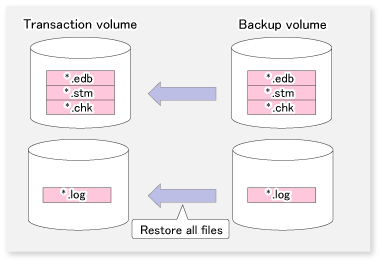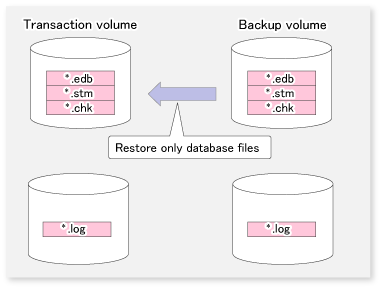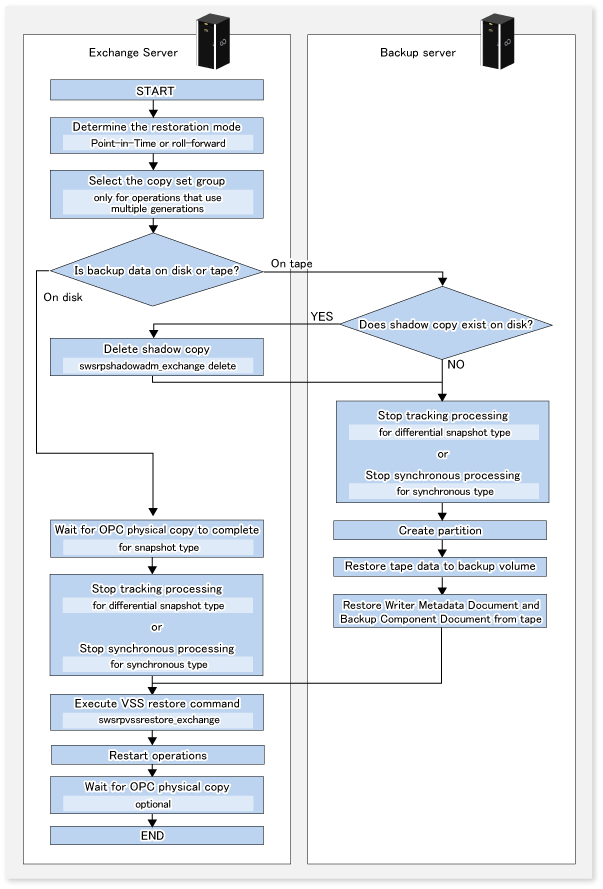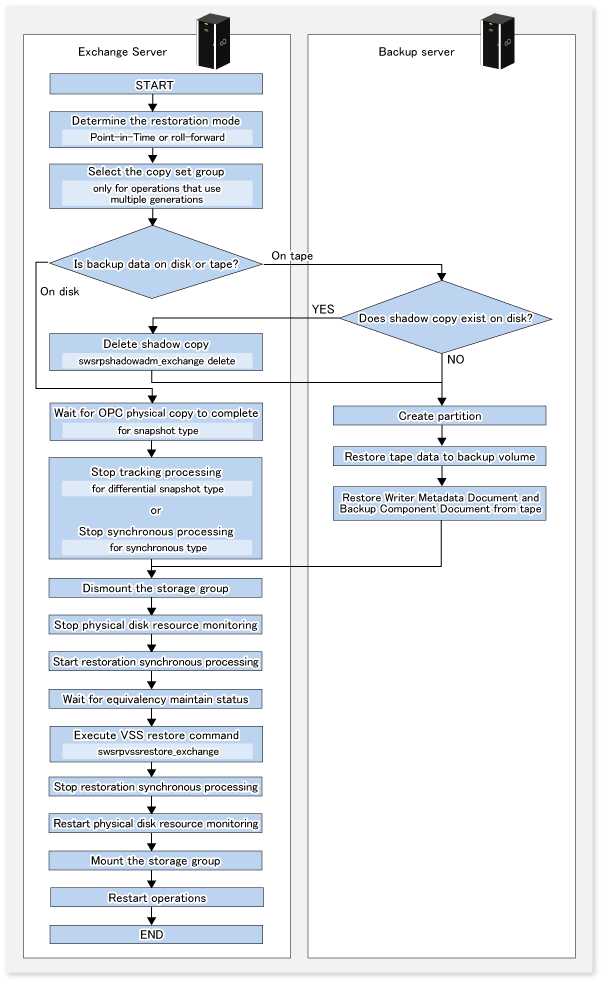The following steps must be completed before performing a restoration:
8.1.5.1.4 Stopping resource monitoring for the physical disk (only when MSCS is operating)
8.1.5.1.5 Stopping the EC/REC session (only for synchronous type backups)
8.1.5.1.6 Stopping the QuickOPC session (only for differential snapshot type backups)
For Exchange Server 2007 and Exchange Server 2003, the steps that must be completed before performing a restoration are as follows.
Steps | Restore Methods | |
|---|---|---|
OPC | EC/REC | |
Dismounting the storage group (when performing synchronous restoration or with Exchange Server 2007) | Not required | Required |
Stopping resource monitoring for the physical disk | Required | Required |
Stopping the EC/REC session (only for synchronous backup) | Required only for synchronous type backups | Required only for synchronous type backups |
Stopping the QuickOPC session (only for differential snapshot backup) | Required only for differential snapshot type backups | Required only for differential snapshot type backups |
Starting restoration synchronous processing and coordinating equivalence maintenance state (only when performing synchronous restoration) | Not required | Required |
Steps | Restore Methods | |
|---|---|---|
OPC | EC/REC | |
Dismounting the storage group (when performing synchronous restoration or with Exchange Server 2007) | Required | Not supported |
Stopping resource monitoring for the physical disk | Required | Not supported |
Stopping the EC/REC session (only for synchronous backup ) | Required only for synchronous type backups | Not supported |
Stopping the QuickOPC session (only for differential snapshot backup) | Required only for differential snapshot type backups | Not supported |
Starting restoration synchronous processing and coordinating equivalence maintenance state (only for synchronous restoration) | Not required | Not supported |
Confirm an environmental setting is done by the same composition as the backup referring to "8.1.3 Preparation".
Under Exchange Server 2007, use the Exchange Management Console to specify the [Overwrite this database when restoring] option for all stores in the target storage group.
To restore using synchronous restoration or with Exchange Server 2007, use the Exchange system manager or Exchange Management Console and dismount all of the stores in the storage group that is to be restored. After dismounting the stores, close the Exchange system manager or the Exchange Management Console.
When the Exchange Server 2007 is running on MSCS, the transaction volume that is the restoration destination is an MSCS shared volume. Therefore, resource monitoring for the target physical disk must be stopped before a restoration is executed. If restoration is executed without stopping resource monitoring, failover will happen for the cluster group.
Note
The disks for which resource monitoring is to be stopped differ according to the restoration method. Refer to "8.1.5.2 Executing the restoration" for more information.
For "Point-in-Time" restorations, all physical disk resources where storage groups (files with extensions *.edb, *.stm, *.log and *.chk) are located must be stopped.
For roll-forward restorations, only physical disk resources where database files (files with extensions *.edb and *.stm) are located must be stopped. In this case, no problems will occur if resource monitoring is stopped for all physical disk resources where storage groups are located.
Stop resource monitoring by switching the resources to maintenance mode by using the cluster command.
[Example (Switching physical disk resource "Disk J:" to maintenance mode)]
C:\>cluster ExampleCluster res "Disk J:" /maint:on Setting maintenance mode for resource 'Disk J:' Resource Group Node Status -------------------- -------------------- --------------- ------ Disk J: GRP1 NODE1 Online(Maintenance) C:\> |
For synchronous type backups, all EC or REC sessions that have been set up on the transaction disk must be cancelled using swsrpvsssync_exchange (Exchange VSS synchronous processing command) before the restoration is executed. The EC/REC sessions that have been set up for the transaction disk can be checked using swsrpshadowadm_exchange (Exchange VSS shadow copy management command).
Note
Restoration cannot be executed if there are any backup disks on the transaction disk array that are being copied via EC/REC, or that are suspended, or in equivalency maintenance state.
For differential snapshot type backups, all of the QuickOPCs that have been set up on the transaction disk must be cancelled using swsrpshadowadm_exchange (Exchange VSS shadow copy management command) before the restoration is executed.
Note
Restoration cannot be executed if there are any backup disks on the transaction disk that are undergoing QuickOPC.
In order to cancel QuickOPC where physical copies are in progress, the shadow copies must be deleted first.
If restoration synchronous processing has been started on the volume being restored, synchronous processing waits until equivalency maintenance status is reached.
Start restoration synchronous processing using swsrpstartsync (Synchronous processing start command).
Use either swsrpstat_exchange (Exchange operation status display command) or swsrpstat (Operation status display command) to wait until synchronous processing reaches equivalency maintenance state.
Note
The volumes that are subject to restoration synchronous processing are dependent on the restoration method.
Restoration is performed separately for each storage group, using swsrpvssrestore_exchange (Exchange VSS restore execution command) on the Exchange server. When this command is executed, all of the databases (i.e. stores) in the storage group are dismounted. Restoration is performed using Advanced Copy functions, but the processing content is different depending on the copy execution status when the restoration command is executed:
If restoration synchronous processing is not being performed, restoration is performed by starting an OPC logical copy.
If restoration synchronous processing is being performed and is in equivalency maintenance state, restoration is performed by suspending the EC or REC functions.
There are two restoration methods:
Point-in-time restoration (restoring to the point when the (last) backup was taken)
Roll forward restoration (restoring to the latest point)
Point-in-time restoration works by restoring all of the databases in the storage group to the state they were in when the backup was taken. Point-in-time restorations are executed by specifying the -point option with swsrpvssrestore_exchange (Exchange VSS restore execution command). If the -point option is specified, this command will restore the storage group to the point when the backup was taken by restoring all of the files (files with extensions *.edb, *.stm, *.log and *.chk) that make up the storage group.
Figure 8.26 Point-in-time restoration

Example:
C:\>set SWSTGNODE=nodeAGT C:\>C:\Win32App\AdvancedCopyManager\bin\swsrpvssrestore_exchange -evs VSVR -point -sgname FirstStorageGroup -copygrp BK1 swsrpvssrestore_exchange successfully completed C:\> |
Roll forward restorations restore all of the databases in the storage group to the latest point.
Roll forward restorations are executed by specifying the -roll option with swsrpvssrestore_exchange (Exchange VSS restore execution command). If the -roll option is specified, the restore is performed as follows:
Only database files (with extensions *.edb and *.stm) are restored.
Logs are applied using the log files that exist on the transaction volume.
Databases are restored to the latest point.
Figure 8.27 Roll forward restoration

Example:
C:\>set SWSTGNODE=nodeAGT C:\>C:\Win32App\AdvancedCopyManager\bin\swsrpvssrestore_exchange -evs VSVR -roll -sgname FirstStorageGroup -copygrp BK1 swsrpvssrestore_exchange successfully completed C:\> |
Note
In order to execute a roll forward restoration, the following conditions must be met:
All of the transaction logs that have been created since the latest complete backup was taken must exist.
The generation numbers (For Exchange Server 2007, the "XXXXXXXX" part of the EnnXXXXXXXX.log, and for Exchange Server 2003, "XXXXX" part of E0nXXXXX.log) of the existing log files must be consecutive.
A new backup must be created immediately after the database path is changed.
A new backup must be created immediately after the commands ESEUTIL /p (restores faults or damaged databases) or ESEUTIL /d (defrags or compresses databases) are executed.
A backup of all databases in the storage group must be taken immediately after any databases are added or deleted.
The following steps must be completed before performing a restoration:
Stop restoration synchronous processing (only when performing synchronous restoration).
Restart resource monitoring for physical disks.
Mount the storage group.
For Exchange Server 2007 and Exchange Server 2003, the steps that must be completed before performing a restoration are as follows.
Steps | Restore Methods | |
|---|---|---|
OPC | EC/REC | |
Stopping restoration synchronous processing (only when performing synchronous restoration) | Not required | Required |
Restarting resource monitoring for physical disks | Required | Required |
Mounting the storage group | Required only for point-in-time restorations | Required only for point-in-time restorations |
Steps | Restore Methods | |
|---|---|---|
OPC | EC/REC | |
Stopping restoration synchronous processing (only when performing synchronous restoration) | Not required | Not supported |
Restarting resource monitoring for physical disks | Required | Not supported |
Mounting the storage group | Required | Not supported |
Stop restoration synchronous processing by executing swsrpcancel (Replication cancellation command) on the Exchange server.
Example:
C:\>set SWSTGNODE=nodeAGT C:\>C:\Win32App\AdvancedCopyManager\bin\swsrpstat_exchange -sgname FirstStorageGroup Server Original-Volume Replica-Volume Direction Status Execute EXCHG-SVR g1d1p1@EXCHG-SVR g1d11p1@BKUP-SVR reverse suspend ---- EXCHG-SVR g1d2p1@EXCHG-SVR g1d12p1@BKUP-SVR reverse suspend ---- EXCHG-SVR g1d1p1@EXCHG-SVR g1d13p1@BKUP-SVR ---- ---- ---- EXCHG-SVR g1d2p1@EXCHG-SVR g1d14p1@BKUP-SVR ---- ---- ---- C:\>C:\Win32App\AdvancedCopyManager\bin\swsrpcancel g1d11p1@BKUP-SVR g1d1p1@EXCHG-SVR FROM=g1d3p1@BKUP-SVR, TO=g1d1p1@EXCHG-SVR swsrpcancel completed C:\>C:\Win32App\AdvancedCopyManager\bin\swsrpcancel g1d12p1@BKUP-SVR g1d2p1@EXCHG-SVR FROM=g1d4p1@BKUP-SVR, TO=g1d2p1@EXCHG-SVR swsrpcancel completed C:\>C:\Win32App\AdvancedCopyManager\bin\swsrpstat_exchange -sgname FirstStorageGroup Server Original-Volume Replica-Volume Direction Status Execute EXCHG-SVR g1d1p1@EXCHG-SVR g1d11p1@BKUP-SVR ---- ---- ---- EXCHG-SVR g1d2p1@EXCHG-SVR g1d12p1@BKUP-SVR ---- ---- ---- EXCHG-SVR g1d1p1@EXCHG-SVR g1d13p1@BKUP-SVR ---- ---- ---- EXCHG-SVR g1d2p1@EXCHG-SVR g1d14p1@BKUP-SVR ---- ---- ---- C:\> |
When the Exchange server is running on MSCS, restart resource monitoring by cancelling maintenance mode for the physical disks where resource monitoring has been stopped.
[Example (Releasing physical disk resource "Disk J:" from maintenance mode)]
C:\>cluster ExampleCluster res "Disk J:" /maint:off Clear maintenance mode for resource 'Disk J:' Resource Group Node Status -------------------- -------------------- --------------- ------ Disk J: GRP1 NODE1 Online C:\> |
For point-in-time restore under Exchange Server 2003, use the Exchange system manager to mount all stores that have been dismounted. For roll forward restorations, the stores do not need to be mounted, as they are mounted already.
Under Exchange Server 2007, use the following procedure to mount the stores:
For roll forward restorations, either delete or rename the CHK file (EXX.chk). (For Point-in-Time restorations, do not perform this procedure.)
Use the Exchange Management Console to mount all the stores that have been dismounted.
When data backed up to tape is to be restored, the backup data on the tape first needs to be restored on the backup server and then the swsrpvssrestore_exchange (Exchange VSS restore execution command) needs to be entered.
If the backup volume is used as a shadow copy, the backup data on the tape must be restored after deleting the shadow copy. The figure below shows the flow of a restoration from tape.
Figure 8.28 Snapshot restoration (restoration performed using OPC)

Figure 8.29 Synchronous restoration (restoration performed using EC or REC)
